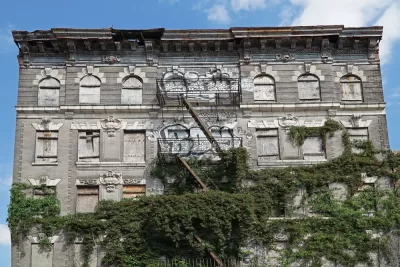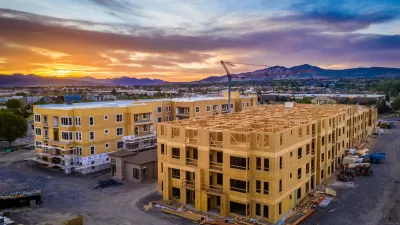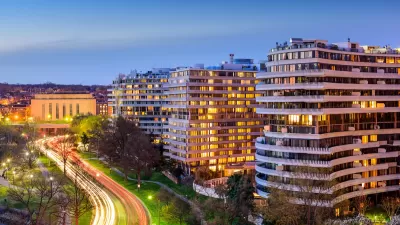Is the existence of vacant apartments an excuse not to build new housing?

One argument against new housing is that old housing is already full of vacancies—so why build new housing when we can just somehow force apartment hunters into the old housing? People who believe this tend to believe that existing vacancies are simply sat on by rich owners, who are waiting for the units to appreciate.
But this argument is wrong for two reasons. First, it is based on the assumption that there is no good reason that an apartment should be vacant. But in fact, vacancies are natural in a functioning market: if an apartment is in the process of being rented or sold, it will be temporarily vacant. If the apartment is being renovated, it will be temporarily vacant. According to the Census Bureau, many vacant housing units are in one of these categories: 8.1 percent of all metro area units are vacant, and nearly half of those are for rent, for sale, or awaiting occupancy. About half of the rest are classified by the Bureau as, "for occasional use" or "temporarily occupied by persons with usual residence elsewhere."*
Second, if vacancies were a result of out-of-control wealth, the most expensive cities would have the highest vacancy rates, and the cheapest cities would have the fewest vacancies. But this is generally not the case—in fact, expensive cities tend to have slightly lower vacancy rates.
First let's look at rental vacancy rates in the most notoriously expensive metro areas—metros with over 4 million people where the median house costs over $400,000. New York's vacancy rate is 4 percent, San Francisco's 3.9 percent, Los Angeles's 3.6 percent, and Boston's a stunningly low 1.7 percent. San Jose, a smaller but extremely expensive metro, has a vacancy rate of only 2.5 percent.
By contrast, let's look at the cheaper large metros, where median housing prices are under $250,000. The largest relatively low-cost metros are Dallas, Houston, Chicago, Philadelphia, Atlanta, and Detroit. Their vacancy rates are, respectively, 6.7 percent, 10.6 percent, 5.7 percent, 8.4 percent, 7.8 percent, and 4.7 percent. Not one of the high-cost metros has a vacancy rate as high as Detroit's 4.7 percent!
Similarly, none of the medium-cost large metros (e.g., Phoenix, Washington, and Miami) have higher vacancy rates than any of the high-cost metros, although Phoenix ties with metro New York at 4 percent, Washington has a higher 5.9 percent rate, and Miami a 7.8 rate. Thus, of the nine large metros where houses cost under $400,000, not one has as many vacancies as San Francisco, Los Angeles, or Boston, and one has a vacancy rate comparable to metro New York.
One possible flaw in the above discussion its limitation to rental vacancies (as opposed to condominiums that are not on the rental market) and includes suburbs. If you look at overall vacancy rates for central cities, the correlation between low cost and high vacancy is less overwhelming—but it still exists.
The four high-cost central cities discussed above have overall housing vacancy rates between 6.4 percent (Los Angeles) and 9.1 percent (New York City). By contrast, the five low-cost cities have higher vacancy rates. Detroit has an astounding 29.2 percent vacancy rate. What about the more prosperous low-cost Sunbelt cities? Atlanta has a 18.2 percent vacancy rate, Houston an 11.1 percent rate, and Dallas a 10 percent vacancy rate. The two low-cost Rustbelt cities (Chicago and Philadelphia) also have double-digit vacancy rates—12.8 percent for Chicago, 13 percent for Philadelphia. The least "vacant" cities still have vacancy rates higher than that of New York City, and not one has a vacancy rate as low as any of the high-cost cities.
What about the central cities of the medium-cost metros? They look more like the central cities of the low-cost metros: Phoenix has a vacancy rate of 10.6 percent, Washington has a vacancy rate of 9.8 percent, and Miami has a vacancy rate of 16.2 percent.
Of course, all of this should be common sense: low supply normally equals high price, and it therefore should not be surprising that places with low vacancy rates have high prices—even if the correlation is somewhat imperfect.
*A more detailed discussion of the types of vacancies can be found on page 8 of a recent paper by Shane Phillips of the UCLA Lewis Center, which focuses in vacancies in Los Angeles.

Manufactured Crisis: Losing the Nation’s Largest Source of Unsubsidized Affordable Housing
Manufactured housing communities have long been an affordable housing option for millions of people living in the U.S., but that affordability is disappearing rapidly. How did we get here?

Americans May Be Stuck — But Why?
Americans are moving a lot less than they once did, and that is a problem. While Yoni Applebaum, in his highly-publicized article Stuck, gets the reasons badly wrong, it's still important to ask: why are we moving so much less than before?

Research Shows More Roads = More Driving
A national study shows, once again, that increasing road supply induces additional vehicle travel, particularly over the long run.

How Protecting Kauaʻi’s Forests Safeguards Fresh Water
A University of Hawaiʻi study shows that protecting Kauaʻi’s native forests from invasive species significantly boosts groundwater recharge, making it a cost-effective strategy to secure fresh water and enhance climate resilience.

Gary, Indiana to Expand Transit Service, Bike Share
The city plans to launch a bike share system in April and expand service on its bus routes.

Pittsburgh Rolls Out Electric School Buses
Pittsburgh Public Schools has launched its first electric school buses, with plans to fully electrify its fleet over the next 14 months, aiming to create a cleaner, more sustainable transportation system supported by new charging infrastructure.
Urban Design for Planners 1: Software Tools
This six-course series explores essential urban design concepts using open source software and equips planners with the tools they need to participate fully in the urban design process.
Planning for Universal Design
Learn the tools for implementing Universal Design in planning regulations.
City of Moreno Valley
Institute for Housing and Urban Development Studies (IHS)
City of Grandview
Harvard GSD Executive Education
NYU Wagner Graduate School of Public Service
City of Cambridge, Maryland
Newport County Development Council: Connect Greater Newport






























